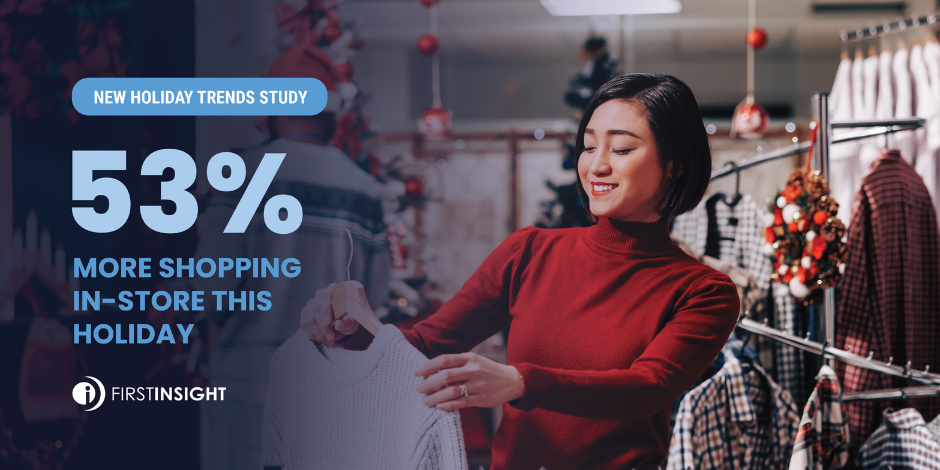First Insight Also Finds Post-Election Spending Slowdown as One-Third of Consumers Plan to Cut Holiday Budgets
Pittsburgh, PA – November 25, 2024 – Shoppers are returning to brick-and-mortar stores in significant numbers this holiday amid a notable cutback in post-election seasonal spending, according to a new consumer survey by First Insight, a global leader in customer-driven AI intelligence. The research reveals a 53% increase in consumers who plan to shop only in-stores compared to last year, while intentions to shop only online have dropped 21%. This notable shift underscores the evolving dynamics of consumer behavior and highlights key areas for retailers to adapt in order to drive revenue and customer satisfaction.
“This year’s holiday season highlights a return to the essentials—competitive pricing and convenience,” said Greg Petro, CEO of First Insight. “Our insights reveal not only a strong preference for in-store shopping and the growing importance of loyalty programs but also suggests a willingness to invest in premium services like faster shipping. Retailers who adapt to these shifts by providing exceptional experiences and meaningful value will emerge as leaders during the critical year-end shopping season.”
Key Insights
This holiday season, consumers are rediscovering the allure of brick-and-mortar stores. In-store shopping intentions have risen by 53% year-over-year, suggesting a potential shift away from the pandemic-driven dominance of online shopping. However, 48% of shoppers plan to visit both physical and digital stores to check off their holiday lists.
The importance of quality and value in driving in-store holiday shopping decisions has significantly declined this year. Only 35% of consumers cited it as a factor in 2024, compared to 50% in 2022—a 30% drop. This shift highlights evolving priorities as shoppers reassess what draws them to physical stores during the holiday season.
Interestingly, shipping costs seem to be less of a deterrent this year, as 36% more consumers are willing to spend above $20 on delivery, indicating a growing willingness to pay a premium for faster shipping. This trend is particularly prevalent among Gen Z (nearly 25%) and male shoppers (23%), potentially indicating a greater tendency for last-minute purchases.
Loyalty programs are also gaining traction, with a 64% rise in shoppers influenced by their benefits. This presents a valuable opportunity for retailers to leverage customer retention strategies and foster long-term loyalty well beyond the holiday season.
Meanwhile, social media's influence on holiday shopping appears to be waning. The study found a 20% drop in consumers who are turning to platforms like Instagram and Pinterest for inspiration, although affluent shoppers remain active purchasers on social commerce channels. Nearly two-thirds of shoppers with incomes over $250,000 plan to make purchases directly on social media platforms, favoring Facebook (75%) and YouTube (69%) during their shopping journey.
The recent U.S. presidential election seems to have ushered in a period of cautious spending for some consumers, with one-third of shoppers planning to reduce their holiday budgets. This sentiment is further reflected in the waning popularity of gift cards (down 11%) and a declining preference for big-box retailers like Walmart and Target (down 51%) and online marketplaces such as Amazon and eBay (down 66%). Also of note, coupons appear to be falling out of favor. Only 6% of respondents plan to use more coupons this year, a significant drop from 27% in 2022—a 78% decrease.
This year, more shoppers are delaying their holiday purchases, with a 44% increase in those planning to start shopping right after Thanksgiving on Black Friday, Cyber Monday, and even in the weeks and days leading up to Christmas. This later start suggests a shift in consumer behavior, as shoppers wait for better deals or align their purchases with more immediate needs, creating compressed demand windows for retailers to navigate.
Footwear stands out as the only product category with a positive trend in e-commerce shopping plans, showing a 19% increase in online purchase intentions. This uptick contrasts with a broader trend of reduced seasonal spending across other categories.
"These findings provide valuable insights for retailers navigating the complexities of the holiday season," added Petro. "Retailers who successfully adapt to these evolving preferences—offering seamless omnichannel experiences, value-driven loyalty programs, and meeting demands for convenience—will win this holiday season."
Methodology
This study was conducted online among a nationally representative sample of 1,560 consumers in the U.S. between November 6-8, 2024.
About First Insight
Founded in 2007, First Insight transformed retail decision-making by combining AI, predictive analytics, and human insight. As a leader in human-AI collaboration for over 17 years, First Insight has empowered brands—including Under Armour, Woolworths, Family Dollar, Kohl’s, and Francesca’s—with actionable Voice of the Customer (VoC) insights to anticipate shopper preferences, launch winning products, and optimize strategies.
Today, First Insight leads the industry in AI and generative AI applications for retail with its proprietary Value Score™, which directly impacts financial outcomes like increased sales, higher margins, and reduced markdowns. By blending human creativity with AI-driven analytics, First Insight helps companies eliminate guesswork, enhance customer satisfaction, boost profitability, and stay competitive. Committed to driving sustainable growth, First Insight is transforming how retailers engage with and understand their customers. Discover more at www.firstinsight.com.














